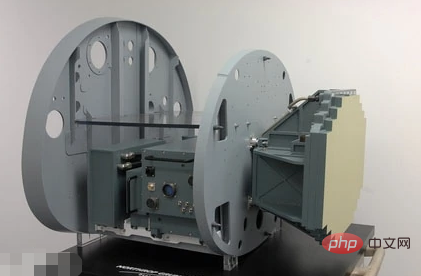
Phased array radar refers to a phase-controlled electronically scanned array radar, which is a type of radar. With the ability of phased array radar to quickly and accurately convert beams, the radar can complete scanning of the entire airspace within one minute. It is a radar array composed of a large number of identical radiation units.

The operating environment of this tutorial: Windows 10 system, DELL G3 computer.
Phased array radar is a phase-controlled electronically scanned array radar,
Its ability to quickly and accurately switch beams This enables the radar to complete scanning of the entire airspace within 1 minute. The so-called phased array radar is a radar area array composed of a large number of identical radiating units. Each radiating unit is independently controlled by wave control and phase shifters in phase and amplitude, and can obtain accurate and predictable radiation patterns and beam pointing. When the radar is working, the transmitter distributes the power to each antenna unit through the feeder network, radiates the energy through a large number of independent antenna units and combines the power in space to form the required beam pointing
Phased array radar ( PAR) refers to scanning the array radar through phase control electronics, using a large number of individually controlled small antennas to arrange the units, and finally forming an antenna array, and each antenna unit is controlled by its own independent switch to form different phase beam. The transmission of the phased array uses an interference principle to form a nearly straight radar main lobe. Many side lobes are generated because the combined antenna elements are uneven.
Types
Phased array radar can be divided into two categories. First, the passive type, or PESA for short, is a radar with relatively low technical performance. It has been matured in the 1980s and is used on ships and small and medium-sized aircraft. The second type is radar technology that has better performance than the first type, has good development prospects, and has higher technical performance. This technology was only applied in the late 1990s and began to be used in fighter aircraft and ship-based systems. Yes, this technology is "Active Active (AESA)".
Features
Compared with other radars, phased array radar has strong vitality and flexibility because it is far superior to Compared with general radars that use mechanical scanning, its characteristics mainly include the following aspects.
Target multiple targets at the same time
Phased array radar uses electronic scanning, and its beam direction is flexible, allowing scanning to be performed quickly and achieved Simultaneous tracking of multiple targets and cooperation with computers can effectively discover, explore and track multiple targets in different directions and heights. At the same time, it can guide multiple missiles to attack numerous air targets. Therefore, phased array radar is mostly used in air strikes with many targets, different directions and different levels.
Diversity of functions and strong mobility
Phased array radar is a system that can replace multiple dedicated radars. It can form multiple beams at the same time and Have independent control over it. These beams can search, explore, identify, track, illuminate targets, and guide missiles. Because of this, it can greatly reduce the weapon system equipment, thereby improving the system's maneuverability.
Strong resistance to interference

Phased array radar has very high power and can manage energy reasonably , and controls the main lobe gain to allocate different energy and transmit according to different directions. This is more beneficial to the suppression of adaptive side lobes. It is also conducive to adaptive resistance to various interferences, and can quickly detect long-distance targets and targets on small radar reflection surfaces. At the same time, it can also resist anti-radiation missiles.
The transmission system of phased array radar consists of dozens to hundreds of power amplification modules. It uses centralized transmission through the phased array antenna, centrally feeds the antenna array and controls the beam direction through phase shifting. The feeder loss is large, and the amplification module failure rate is high. After the phased array transmitter has been working for a long time, individual power amplification modules and cables often deteriorate. Although the radar as a whole will not stop working, the radiation pattern and beam direction will shift, thus affecting the radar accuracy and detection. The range has an impact, and there is an urgent need for a low-cost, effective and reliable method to achieve effective real-time monitoring of all power amplification modules of the transmitter, thereby reducing the difficulty of phased array radar inspection and maintenance.
For more related knowledge, please visit the FAQ column!
The above is the detailed content of What is phased array radar. For more information, please follow other related articles on the PHP Chinese website!
 What is phased array radar
What is phased array radar
 What to do if there is an IP conflict
What to do if there is an IP conflict
 Property management system software
Property management system software
 What are the methods to change password in MySQL?
What are the methods to change password in MySQL?
 ERR_CONNECTION_REFUSED
ERR_CONNECTION_REFUSED
 Introduction to hard disk interface types
Introduction to hard disk interface types
 okex trading platform app official website
okex trading platform app official website
 What to do if windows photo viewer is out of memory
What to do if windows photo viewer is out of memory